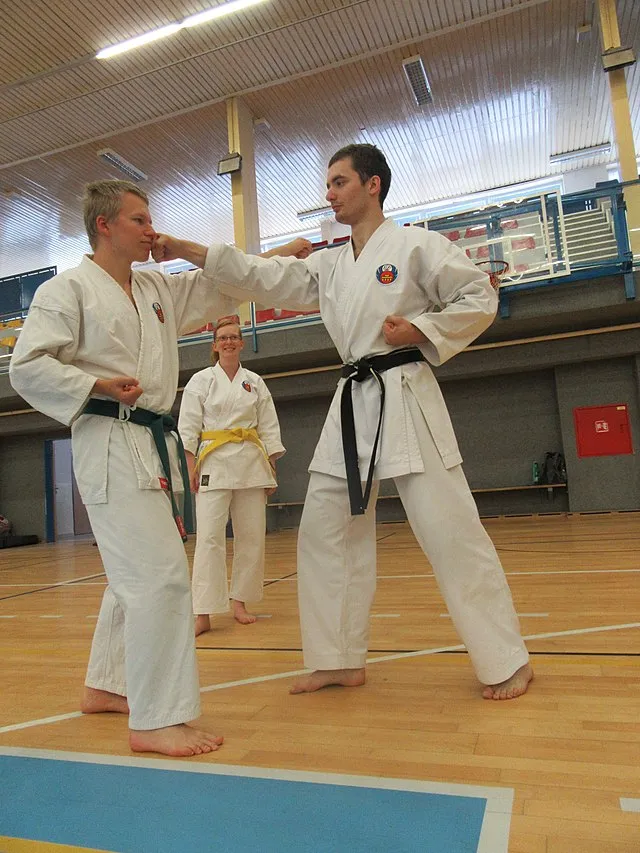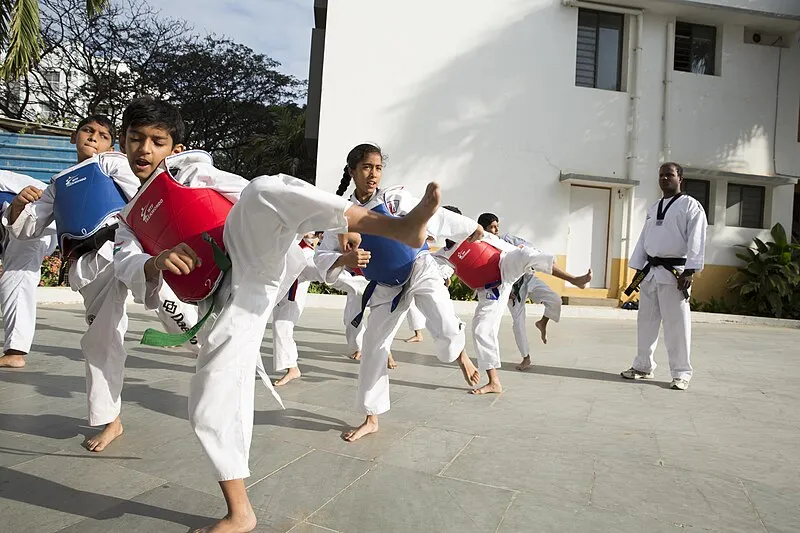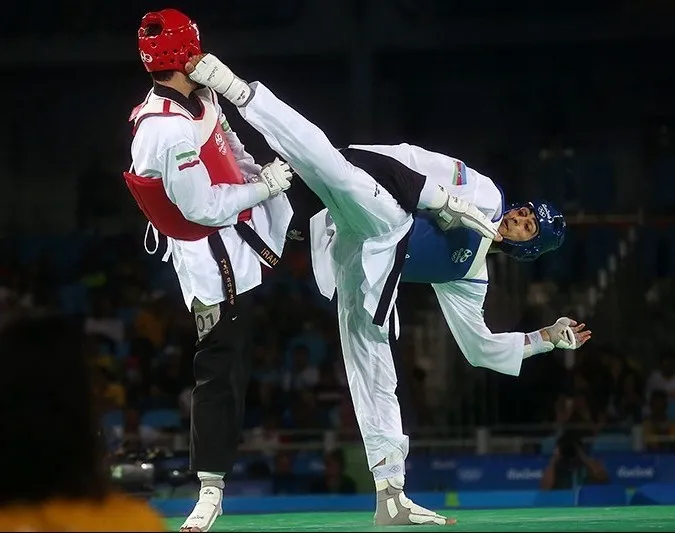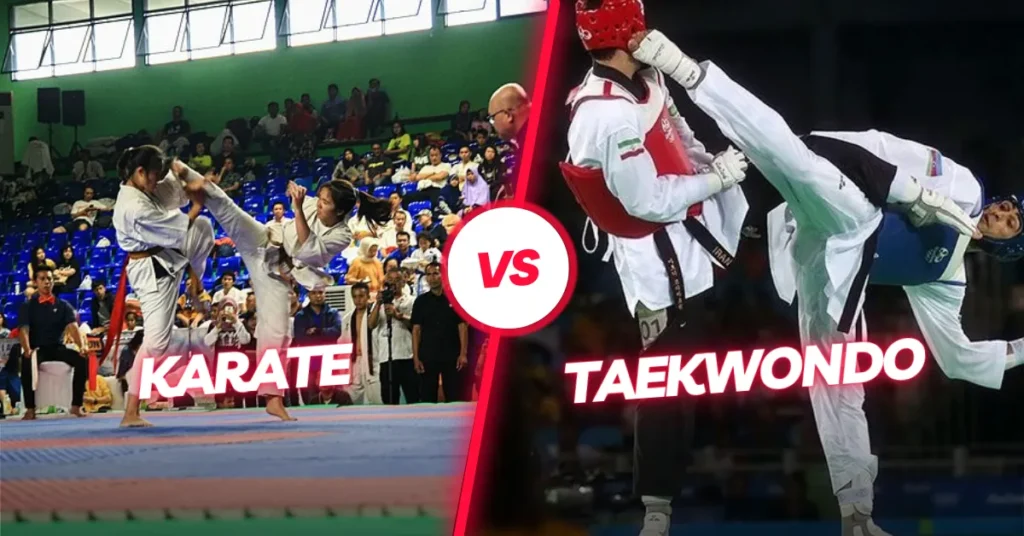Did you know that karate and taekwondo are two of the most widely practiced martial arts in the world? With millions of practitioners spanning across different countries, these disciplines have gained immense popularity due to their focus on self-defense, discipline, and physical fitness.
While both karate and taekwondo share common goals, they have distinct differences in techniques, training methods, and histories. Understanding these differences is crucial for those considering learning a martial art form or simply wanting to explore the unique aspects of each discipline.
Table of Contents
Key Takeaways
- Karate and taekwondo are two popular martial arts disciplines with millions of practitioners worldwide.
- While both emphasize self-defense and physical fitness, they have different techniques and training methods.
- Karate emphasizes hand techniques and uses kicks as backup, while taekwondo focuses more on kicking techniques.
- Both martial arts require discipline, commitment, and consistent training to master the techniques effectively.
- Choosing between karate and taekwondo depends on personal preferences, goals, and interests.
Karate: Hand Techniques and Backup Kicks
Karate, a renowned form of martial arts, is recognized for its emphasis on hand techniques while using kicks as backup. One of the signature moves in karate is the popularized “karate chop” or shuto uchi. Originating around 500 years ago on the Japanese island of Okinawa, karate incorporates influences from both Japanese and Chinese martial arts styles. Karate practitioners dedicate their time to mastering different stances, punches, kicks, and blocks to enhance their skills.

In karate, while kicks are indeed used, the primary focus remains on hand techniques, which are considered central to the discipline. Practitioners often rely on their hands, while keeping their legs grounded, allowing for precise and accurate strikes. With dedicated practice and training, karate practitioners develop strong hand techniques, enabling them to engage effectively in close-quarters combat.
| Key Points | Details |
|---|---|
| Style Evolution | The style of karate evolved on the Japanese island of Okinawa around 500 years ago, incorporating influences from Japanese and Chinese martial arts. |
| Signature Move | The popularized “karate chop” or shuto uchi is a signature move in karate. |
| Emphasis | Karate emphasizes hand techniques, making them the focal point of the discipline. |
| Kick Usage | While kicks are part of karate’s repertoire, they are primarily used as backup techniques. |
Taekwondo: Emphasis on Kicking Techniques
Taekwondo, a well-known martial art form, places a significant emphasis on kicking techniques. The belief behind taekwondo is rooted in the idea that the legs possess remarkable power and can serve as the body’s most potent weapon. Taekwondo practitioners dedicate themselves to mastering a diverse array of kicking moves, including spinning and jumping kicks, which add dynamism and visual appeal to their practice.
The leg stance in taekwondo differs from that of karate due to the need for swift execution of kicks. This specialized stance ensures that practitioners are poised and ready to deliver powerful, lightning-fast kicks, showcasing the agility and speed that taekwondo is known for. By placing such an emphasis on kicking techniques, taekwondo practitioners specialize in using their legs to launch devastating and precise offensive maneuvers.
Taekwondo has ancient roots that date back to approximately 50 B.C.E. Developed as a self-defense system, it originated in Korea and has since gained worldwide popularity. However, during the Japanese occupation of Korea, taekwondo, along with other martial arts, faced a ban. This ban, however, did not hinder the determination of taekwondo practitioners, who continued to practice in secret.
At its core, taekwondo focuses on kicks as a primary offensive strategy, while utilizing hand techniques for defensive purposes. This approach enhances the effectiveness of this martial art form, as it harnesses the full potential of the legs while incorporating hand movements strategically for self-defense. With its dynamic kicking techniques, taekwondo offers a unique and thrilling martial arts experience.
History of Karate
The history of karate can be traced back around 500 years ago to the Japanese island of Okinawa. During this time, weapons were banned on the island as a measure to prevent war. As a result, the people of Okinawa turned to hand-to-hand combat for self-defense, leading to the development of the first form of karate.
Karate is a martial art that has been influenced by both Japanese and Chinese cultures. Due to its strategic geographical location, Okinawa was exposed to influences from neighboring countries, including China. These influences played a significant role in the development and evolution of karate techniques.
“Karate does not solely belong to Japan but also draws from the techniques and philosophies of ancient Chinese martial arts,” said Funakoshi Gichin, the first known Okinawan karate master.
Funakoshi Gichin dedicated his life to spreading the teachings of karate across Japan. In 1949, his followers established the Japan Karate Association, effectively promoting the martial arts style. Since then, karate has gained recognition and popularity worldwide, with various styles and schools emerging.
Today, karate is practiced by millions of individuals around the world. Its rich history and global influence have cemented its place as one of the most renowned martial arts disciplines.
| Period | Influences |
|---|---|
| 500 years ago | Okinawa ban on weapons leads to the development of karate |
| Chinese influence | Introduction of Chinese martial arts techniques |
| Funakoshi Gichin era | Spread of karate teachings across Japan |
| 1949-present | Establishment and growth of the Japan Karate Association |
History of Taekwondo
Taekwondo, meaning “the way of the foot and fist,” has ancient roots that trace back to Korea around 50 B.C.E. The martial art was developed as a form of self-defense, combining the Korean words “tae” meaning kick and “kwon” meaning punch or destroy with the hand.
During the early 1900s, Korea was under Japanese occupation, and martial arts like taekwondo were banned. Despite the prohibition, some individuals continued to practice taekwondo in secret to preserve their culture and self-defense skills. Others traveled to China or Japan to learn different martial arts styles, honing their techniques.
When the Japanese occupation ended in 1945, Korea seized the opportunity to rebuild its martial arts culture. In 1955, influential taekwondo masters came together and established standards for teaching and techniques, resulting in the formation of taekwondo as it is known today.
The Japanese occupation and the resilience of taekwondo
“Despite the ban on taekwondo and other martial arts during the Japanese occupation, many dedicated individuals clandestinely practiced and transmitted their knowledge to keep the spirit of taekwondo alive. This resilience and determination laid the foundation for the resurgence and evolution of taekwondo in post-occupation Korea.”
Techniques in Karate and Taekwondo
Karate and taekwondo are two distinct martial arts styles that have their own unique techniques. While both styles involve striking and kicking techniques, there are significant differences in their approach.
Karate
In karate, the emphasis is on hand techniques for offense, with kicks serving as backup moves. The focus is on strong and precise strikes using various hand techniques such as punches, chops, and strikes.

Some of the commonly used hand techniques in karate include:
- Striking with the fist
- Knifehand strikes
- Ridgehand strikes
- Palm heel strikes
- Elbow strikes
Karate practitioners also learn different stances, kicks, and blocks to complement their hand techniques.
Taekwondo
Taekwondo, on the other hand, places a greater emphasis on kicking techniques. It considers the legs as the most powerful weapon and focuses on developing speed, precision, and agility in executing kicks.
Some of the kicking techniques that taekwondo practitioners learn include:
- Front kicks
- Roundhouse kicks
- Side kicks
- Back kicks
- Axe kicks
Taekwondo practitioners also learn spinning and jumping kicks to add variety and complexity to their techniques.
Training and Practice
Both karate and taekwondo require extensive training and practice to develop effective techniques. Practitioners of both martial arts spend hours perfecting their strikes, kicks, and defensive maneuvers through repetitive drills and sparring sessions.
By mastering the techniques in karate and taekwondo, practitioners can build strength, improve coordination, and enhance their martial arts skills.

Forms in Karate and Taekwondo
Both karate and taekwondo have forms that practitioners learn. In karate, these forms are called Kata. Kata consists of a sequence or pattern of movements that practitioners must memorize and execute with precision. It is an essential aspect of karate training and helps in the development of speed, rhythm, memory, and power. Practicing Kata allows karateka to refine their techniques, timing, and accuracy, as well as enhance their overall martial arts skills.
Taekwondo forms, on the other hand, are known as Poomsae. Like Kata, Poomsae also involves memorized movements executed in competitions. It is a set sequence of defensive and offensive techniques performed in a specific pattern. Poomsae is an integral part of taekwondo training and is designed to improve a practitioner’s balance, flexibility, coordination, and concentration. It requires discipline, precision, and a deep understanding of taekwondo principles.
“Forms such as Kata in karate and Poomsae in taekwondo serve as a bridge between basic techniques and practical application. They help martial artists develop muscle memory, focus, and mental discipline, while also showcasing the beauty and elegance of these martial arts forms.”
Both Kata and Poomsae serve as a way for practitioners to express their artistry, as well as provide a means for self-improvement and personal growth. They are an opportunity for individuals to showcase their mastery of techniques and demonstrate their understanding of the martial arts principles and philosophies.
To illustrate the significance of forms in karate and taekwondo, here is a comparison:
| Karate (Kata) | Taekwondo (Poomsae) |
|---|---|
| Consists of a sequence or pattern of movements | Also involves memorized movements executed in competitions |
| Aims to develop speed, rhythm, memory, and power | Improves balance, flexibility, coordination, and concentration |
| Highlights hand techniques and backup kicks | Showcases a variety of kicks and rapid leg movements |
Overall, forms in karate and taekwondo play a fundamental role in the training and development of practitioners. They offer an avenue for self-expression, as well as a way to refine techniques and gain a deeper understanding of the martial arts. Whether it’s the intricate Kata of karate or the dynamic Poomsae of taekwondo, these forms ensure that martial artists continually challenge themselves and strive for excellence.
Competition Rules in Karate and Taekwondo
Karate and taekwondo have specific rules and guidelines that govern their competitions. Understanding these rules is essential for practitioners and participants to succeed in their respective martial arts competitions. Let’s explore the competition rules in both karate and taekwondo.
Karate Competition Rules
In karate competitions, points are awarded for punches and kicks, giving equal importance to both techniques. Competitors showcase their skills by executing various hand strikes and kicks while demonstrating precision, speed, and control. Judges evaluate factors such as form, accuracy, distance, and timing to determine the winner.
Taekwondo Competition Rules
Taekwondo competitions differentiate themselves with a higher emphasis on kicking techniques. Points are primarily awarded for well-executed kicks, showcasing the power, accuracy, and agility of the competitor. Hand strikes are also incorporated in taekwondo competitions but are often utilized for defensive purposes. Judges consider the execution of kicks, form, accuracy, and timing to determine the winner.

Now, let’s take a closer look at the competition rules in karate and taekwondo through a detailed comparison table:
| Karate Competition Rules | Taekwondo Competition Rules |
|---|---|
| Points awarded for punches and kicks | Higher points for well-executed kicks |
| Equal importance given to punches and kicks | Emphasis on kicking techniques |
| Factors considered: form, accuracy, distance, timing | Factors considered: execution of kicks, form, accuracy, timing |
Competition rules are designed to ensure fairness and consistency during karate and taekwondo competitions. Aspiring martial artists should familiarize themselves with these rules to enhance their performance and maximize their chances of success in their respective disciplines.
Benefits of Karate and Taekwondo
Practicing karate and taekwondo offers numerous benefits for both physical and mental health. These martial arts forms not only improve balance and build muscle but also provide a full-body aerobic workout. In addition to the physical benefits, karate and taekwondo instill discipline, patience, and mental strength in practitioners.
Karate, known for its practical self-defense techniques and focus on hand techniques, offers a wide array of benefits. It enhances self-confidence and equips individuals with effective skills for self-defense. The emphasis on hand techniques in karate helps develop overall coordination and precision.
“Karate teaches me discipline and focus. The self-defense techniques I learn make me feel empowered and more secure in my everyday life.” – Sarah, Karate Practitioner
On the other hand, taekwondo provides a unique set of benefits, particularly in terms of fitness and flexibility. With its emphasis on kicking techniques, taekwondo practitioners develop strong leg muscles and improved agility. The diverse range of kicking styles in taekwondo adds excitement and variety to training sessions.
“Taekwondo has helped me improve my balance and flexibility. I love the dynamic kicking techniques, and it has become a great way for me to stay fit.” – David, Taekwondo Practitioner
| Karate | Taekwondo | |
|---|---|---|
| Physical Benefits | Improves balance and coordination Builds muscle strength Provides aerobic workout | Enhances leg strength and agility Promotes overall fitness Increases flexibility |
| Mental Benefits | Instills discipline and focus Builds self-confidence Develops self-defense skills | Cultivates mental strength Promotes goal-setting Enhances perseverance |
| Focus | Hand techniques and backup kicks | Emphasis on kicking techniques |
| Practical Application | Practical self-defense techniques Focus on close combat | Dynamic kicking techniques Long-range combat strategies |
Choosing Between Karate and Taekwondo
The decision to choose between karate and taekwondo ultimately depends on personal preference, goals, and interests. Each martial art offers unique elements that may resonate differently with individuals seeking self-defense skills, physical fitness, and personal development.
If someone is looking to develop a well-rounded set of skills that encompass balanced full-body moves and practical self-defense techniques, karate may be the more suitable choice. Karate emphasizes hand techniques and uses kicks as backup, teaching practitioners discipline, focus, and control over their body.
On the other hand, individuals who prefer a martial art focused on fast and elaborate kicking moves may find taekwondo to be more appealing. Taekwondo places a greater emphasis on kicking techniques and encourages practitioners to develop agility, flexibility, and precision in their movements.
It is highly recommended for individuals who are undecided to try beginner classes in both karate and taekwondo. This allows for firsthand experience and a better understanding of each martial art’s principles, techniques, and training atmosphere. By experiencing both disciplines, individuals can make an informed decision based on their personal preferences and goals.
Key Factors to Consider:
- Preference for hand techniques vs. kicking techniques
- Desired emphasis on practical self-defense vs. elaborate movement styles
- Interest in balanced, full-body moves or specialized kicking techniques
- Compatible training atmosphere and teaching methods
- Availability of reputable dojos or training centers
“The decision to choose between karate and taekwondo ultimately depends on personal preference, goals, and interests.”
– Martial Arts Expert
| Karate | Taekwondo | |
|---|---|---|
| Main Techniques | Hand techniques with kicks as backup | Kicking techniques with hand techniques for defense |
| Emphasis | Balance between hand and leg techniques | Greater emphasis on kicking techniques |
| Training Styles | Focused and disciplined | Energetic and dynamic |
| Philosophy | Self-defense, discipline, and control | Speed, agility, and precision |
| Competition | Equal points for punches and kicks | Higher points for kicks |
Ultimately, choosing between karate and taekwondo comes down to personal preferences and goals. Individuals seeking practical self-defense skills and a focus on hand techniques may prefer karate, while those interested in a diverse range of kicking styles and an emphasis on fitness might lean towards taekwondo.
Both martial arts offer holistic development, fostering physical fitness, mental well-being, and character growth. Whether one chooses karate or taekwondo, the benefits extend beyond the training mat and positively impact various aspects of daily life.
Karate vs Taekwondo: Which is Better?
The debate of which martial art is better, karate or taekwondo, ultimately depends on personal preference and goals. Both karate and taekwondo offer physical and mental benefits, self-defense skills, and opportunities for competition and advancement.
Karate emphasizes hand techniques and backup kicks. It focuses on developing strong punches and strikes, with kicks used as secondary attacks. Karate practitioners train rigorously to enhance their hand-to-hand combat abilities and master various blocking techniques for self-defense.
Taekwondo, on the other hand, focuses primarily on kicking techniques. Known for its powerful and dynamic kicks, taekwondo practitioners strive to perfect their kicking accuracy, speed, and agility. The style places significant emphasis on delivering high, fast kicks from various angles.
When choosing between karate and taekwondo, it is crucial to consider individual preferences, styles, and interests. Some people may prefer the dynamic and acrobatic nature of taekwondo, while others may find karate’s emphasis on hand techniques and self-defense techniques more appealing.
Ultimately, the decision should be based on personal goals. If someone is interested in learning well-rounded martial arts techniques, including strikes, blocks, and kicks, karate may be the better choice. On the other hand, individuals who are fascinated by high-flying kicks and fast-paced movements may find taekwondo more suitable.
Both karate and taekwondo require discipline, dedication, and continuous practice to master the techniques effectively. The training in either martial art offers physical fitness, mental discipline, and self-confidence.
Remember, the benefits and effectiveness of karate or taekwondo ultimately depend on the individual’s commitment, consistency in training, and willingness to learn.
Karate and taekwondo can transform both body and mind, instilling valuable qualities such as discipline, focus, self-control, and perseverance. To determine which martial art is better, aspiring practitioners are encouraged to visit local dojos or training centers, observe classes, and even participate in introductory sessions to get a feel for the style that resonates best with their goals and aspirations.
It’s essential to approach the decision with an open mind, understanding that both karate and taekwondo offer rich histories, distinct techniques, and valuable life lessons.
Conclusion
Karate and taekwondo are two highly respected forms of martial arts that offer unique techniques and rich histories. Karate focuses on hand techniques as the main offensive method, with kicks serving as backup. Taekwondo, on the other hand, places a greater emphasis on powerful kicking techniques.
Both karate and taekwondo provide numerous benefits to practitioners. These martial arts contribute to physical fitness, helping individuals develop strength, agility, and coordination. Additionally, they offer valuable self-defense skills that can enhance personal safety and confidence. Both disciplines also provide opportunities for competition, allowing participants to showcase their skills and progress.
Choosing between karate and taekwondo ultimately comes down to personal preference and goals. Individuals who prefer a more balanced focus on hand and kicking techniques, along with practical self-defense skills, may find karate to be an excellent choice. On the other hand, those who are captivated by powerful kicks and elaborate kicking styles may be better suited to taekwondo.
To make an informed decision, it is recommended to try beginner classes in both karate and taekwondo, as they are usually free. This firsthand experience will allow you to determine which martial art resonates with you. Whether you choose karate or taekwondo, embracing the discipline and passion of these martial arts will undoubtedly yield personal growth, physical fitness, and a deeper understanding of the art of self-defense.
FAQ
Is it better to learn Taekwondo or Karate?
The choice between learning Taekwondo or Karate depends on individual preferences, objectives, and physical abilities. Taekwondo emphasizes kicking techniques, making it suitable for individuals who prefer using their legs as the primary weapon. On the other hand, Karate offers a more balanced approach with equal emphasis on hand and foot strikes, appealing to those who seek a versatile martial arts style.
What is the difference between karate and taekwondo?
Karate emphasizes hand techniques and uses kicks as backup, while taekwondo involves more kicking and uses hands as backup.
Does Taekwondo have more kicks than Karate?
Yes, Taekwondo generally incorporates more kicks than Karate. Taekwondo places a heavy emphasis on kicking techniques, utilizing the legs as the primary weapon. In contrast, while Karate also includes kicking techniques, it maintains a more balanced focus with equal attention given to hand strikes.
Can I learn both Karate and Taekwondo?
It is possible to learn both Karate and Taekwondo simultaneously. Some practitioners choose to study multiple martial arts disciplines to gain a broader understanding of self-defense techniques and martial arts principles. However, it requires dedication, commitment, and careful management of training schedules to effectively learn and progress in both disciplines.
Can Karate beat kung fu?
The outcome of a confrontation between Karate and Kung Fu practitioners would depend on various factors such as individual skill level, technique, strategy, and physical attributes. Both Karate and Kung Fu are respected martial arts with distinct styles and techniques. While Karate is a Japanese martial art and Kung Fu encompasses various Chinese martial arts styles, there is no definitive answer to whether Karate can beat Kung Fu as outcomes would vary based on the specific context and abilities of the practitioners involved.
What are the benefits of practicing karate and taekwondo?
Practicing these martial arts forms can improve balance, build muscle, and provide a full-body aerobic workout. They also teach discipline, patience, and mental strength.
How do I choose between karate and taekwondo?
The decision to choose between karate and taekwondo depends on personal preference, goals, and interests. It is recommended to try taking beginner classes in both disciplines to determine which martial art style is best suited.
Where did taekwondo originate?
Taekwondo originated in Korea.
Where did karate originate?
Karate originated around 500 years ago on the Japanese island of Okinawa and has both Japanese and Chinese influences.



